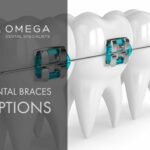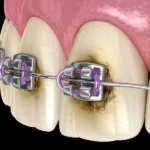All-on-4 vs. All-on-6 Dental Implants

Dental implants have been around a long time. Even the earliest humans found ways to replace missing teeth, and the first implants appeared in the Mayan civilization around 600 AD! Lucky for all of us, technology has advanced from the days when they used shells and stones for their implants, and today we have a wide variety of options for people who are missing one or more teeth due to trauma, disease, or tooth decay.
For those who want to replace their dentures or who need to have an entire row of teeth removed, All-on-6 or All-on-4 dental implants may be the best option.
What are All-on-4 and All-on-6 Dental Implants?
A dental implant is a titanium post covered with a porcelain crown that is secured into the jawbone. The bone naturally fuses to titanium, creating a new root that’s as strong as your original!
However, in the case of multiple missing teeth, it’s not necessary to do one implant per tooth. The strength of the post allows us to secure multiple teeth on just a few posts, which is where those names come from: all the new teeth are attached to four posts, or they’re all attached to six.
Which Is Better For Me?
Whether you need All-on-6 or All-on-4 dental implants will depend upon your mouth and which teeth are missing. If you’re missing one tooth or a couple of teeth in different places, a single implant in each spot is the best solution, anyway.
However, if you’re missing all the upper or bottom teeth, All-on-4 dental implants are probably the way to go. It’s slightly less invasive than All-on-6, though in both cases you get to go home with a temporary arch that looks, feels, and functions like real teeth. After your jaw heals, your permanent arch will be placed, and you can expect a lifetime of chewing and smiling with your implants.
Going for All-on-6 takes careful consideration of many factors. All-on-6 may be more appropriate if you have certain healthy teeth and roots remaining. We also have to consider the strength and density of your jawbone: is there enough there to support six implants? Of course, after they’re in, the pressure from the teeth is distributed over a greater area, which may be easier on your jaw in the long term.
Both are better than dentures! Implants are permanent, so you can brush, floss, eat, talk, and smile as normal—and they feel just like real teeth. They support your jawbone and help prevent bone loss, and they protect the structure of your face.
What Can I Expect from the All-on-4 Procedure?
First, you’ll want to schedule a free dental implant consultation. This is where we’ll consider your medical and dental history, overall health, and the condition of your jawbone and teeth to determine which type of implant is right for you. Depending on your situation, we may need to do some preliminary work, like removing damaged teeth.
The procedure itself only lasts two or three hours! In one visit, your implants will be installed and you’ll have a temporary set of teeth that look and feel real. You can get back to your daily routine almost immediately, though we might recommend sticking to softer foods for a little while. Everyone’s healing process is a little bit different, but the jaw typically heals in about six months. After that, we’ll be able to install your permanent set of teeth, and your dental implant procedure will officially be complete!
Take a look at our complete guide to All-on-4 dental implants for more information.
If you have any questions about All-on-4 dental implants, please contact us! We’ll be glad to answer your questions and get you started on your journey to a healthy smile you can be proud of.





